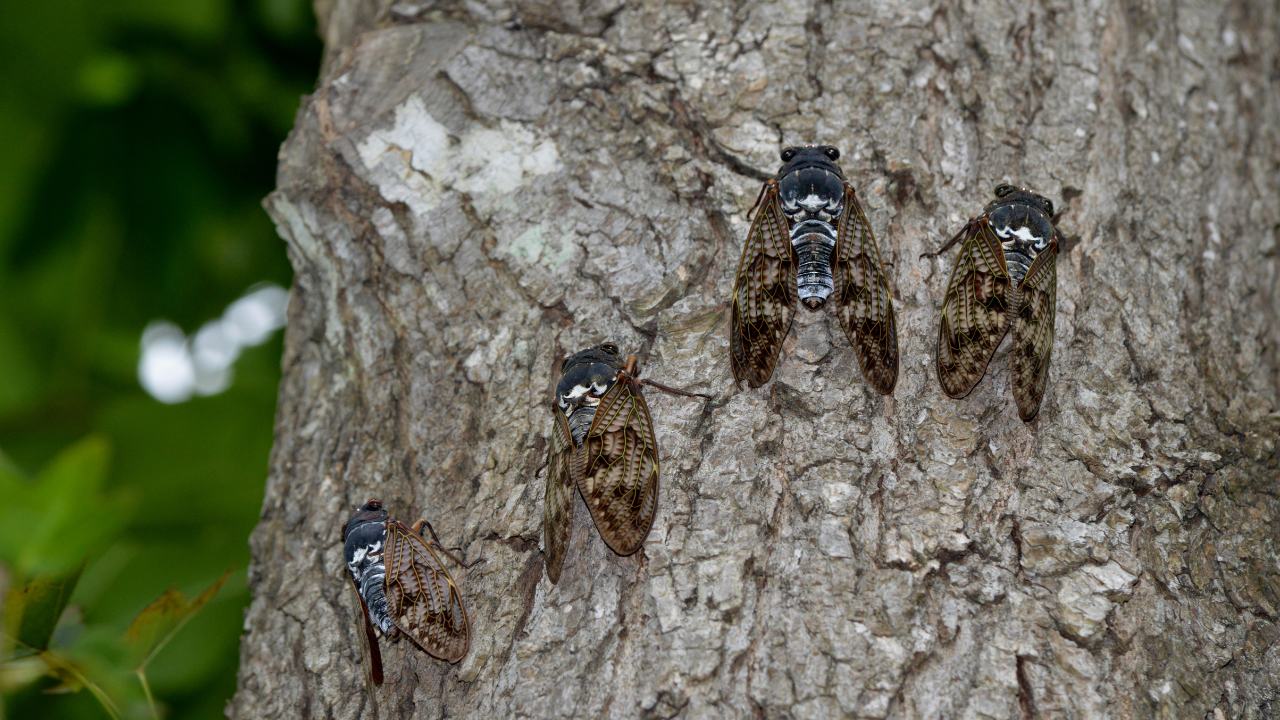
Key Highlights
- What is Cicadapalooza? A trillion of these curious insects will emerge from the ground sometime in April!
- The brood should make their appearance in the Southeast and Midwest.
- Pets are sure to be very curious when this happens and may ingest some.
- It will be noisy and expected to last 6 weeks.
- It may make some pets and horses especially very nervous.
- They are otherwise harmless and do not bite or sting.
- If your pet eats a few, it may cause gut irritation, but gorging could cause intestinal blockage.
- Cicadas are good! They aerate the soil and, when they die, can be raked up and used as fertilizer.
- Do not use pesticides on them. They are harmless!
Introduction

Pets are naturally curious creatures, often drawn to the buzzing sounds and movements of insects like the cicada; their red eyes and clear wings attract pets due to their unique appearance. Pets, especially curious cats, cannot resist bugs that hop and crawl around. Pets are likely to play with them and potentially eat some of them. Don't worry; they are harmless, but this doesn't mean you should let your pet gorge on them, as this could cause stomach upset and even blockage if they eat too many.
Characteristics of Cicadas

Cicadas are fascinating insects known for their distinctive appearance and the loud songs sung by males during the mating season. Here are some key traits that would help you identify a cicada:
Size and Shape: Adult cicadas typically range from 2 to 5 centimeters (about 0.75 to 2 inches) in length, with a wide-set body structure. They possess a somewhat robust body when compared to other insects.
Eyes: One of the most striking features of cicadas is their large, prominent eyes, which are often a bright red, orange, or green color, set wide apart on either side of the head.
Wings: Cicadas have two pairs of wings, with the front pair being significantly larger. The wings are transparent and have a delicate, membranous structure with distinctive veining. When at rest, they hold their wings tented over their bodies or flat against a surface.
Coloration: Their coloration can vary, but many cicadas exhibit a combination of black, brown, and green hues across their bodies and wings. This color scheme helps them blend into their surroundings.
Sounds: Male cicadas are well-known for their loud, buzzing songs, which they use to attract females during mating season. These sounds can be extremely loud, reaching up to 100 decibels, and are produced by the rapid buckling of a special organ called a tymbal located on the sides of the abdominal base.
Life Cycle: While not an immediate visual identification trait, knowing a bit about their unique life cycle might help in identifying them, especially the periodical cicadas. Cicadas spend most of their lives underground as nymphs, emerging only after 13 or 17 years to molt into their adult form, mate, and die within several weeks.
Exuviae: The presence of cicada exuviae (the shed skins of their nymph stage) attached to tree trunks, plant stems, and other surfaces is a telltale sign of recent cicada activity. These exoskeletons closely resemble the nymph form but are empty and brittle.
By observing these distinct characteristics, you can confidently identify cicadas in your environment. Whether you encounter them during one of the remarkable mass emergences or spot a solitary individual, cicadas are truly intriguing insects to observe.
Habitats and Behaviors: Why Pets Find Them Intriguing

Pets are naturally curious creatures, often drawn to the buzzing sounds and movements of insects like the cicada, bee, or spider. Cicadas, with their red eyes and clear wings, attract pets due to their unique appearance. Bees, known for their role in pollination, may entice pets with their vibrant colors and distinct flight patterns. Spiders, although potentially dangerous, can capture a pet's attention with their intricate webs and quick movements. Understanding these insects and arachnids' habitats and behaviors is crucial in preventing pets from encountering harm. It's essential to supervise pets closely in outdoor environments where these creatures may reside to avoid accidental ingestion or stings. Familiarizing pets with the potential risks associated with these insects can help mitigate any dangers they may pose.
Cicadas: Are They Harmful to Pets?

Cicadas can be harmful to pets because their hard exoskeletons can cause digestive issues or obstructions. Ingestion may lead to vomiting, diarrhea, or blockages. It's crucial to monitor pets closely after encounters with cicadas.
Potential Risks Associated with Cicadas
Consult a veterinarian if you suspect your pet has consumed a large number of cicadas to rule out any potential health risks. Check our tummy upset action plan here:
Training Your Pet to Avoid Eating Insects
Train your pet to avoid eating insects, especially spiders and bees. Start by creating a positive reinforcement system using treats or toys to divert your pet's attention from these creatures. Utilize commands like "leave it" or "drop it" during training sessions. Consistency is key; reinforce these commands regularly to instill obedience.
Conclusion
It is crucial for pet owners to be vigilant and knowledgeable about the potential risks associated with insects and arachnids that their pets may encounter. Understanding the characteristics, habitats, and behaviors of creatures like cicadas, bees, and spiders can help prevent unwanted incidents. Immediate action is necessary if a pet consumes an insect or spider, starting with identifying what the pet has ingested and closely monitoring for any adverse reactions. Seeking veterinary care promptly when needed is vital to ensure the well-being of the pet. Preventive measures such as creating safe environments and supervising pets can significantly reduce the chances of ingestion. Lastly, consulting a veterinarian in situations requiring immediate attention and providing ongoing care post-ingestion are essential steps in safeguarding your pet's health and well-being.
What are cicadas?

Cicadas are large insects known for their loud buzzing sounds. They have prominent eyes and membranous wings. These creatures go through a fascinating life cycle, spending years underground before emerging as adults to mate and lay eggs.
Geographic range

Cicadas have a vast geographic range, predominantly found in North America. These insects are particularly abundant in the United States, with various species inhabiting different regions. Their presence extends to areas beyond North America, such as China, Australia, and even parts of Europe. The diversity of cicadas across these regions contributes to the ecosystem in which they thrive. Their unique and widespread distribution showcases their adaptability to a range of environments, from forests to urban areas, making encounters with these buzzing creatures quite common for pets.
Life cycle

The life cycle of cicadas is a fascinating journey marked by distinctive phases. These remarkable insects typically spend the majority of their lives underground as nymphs, feeding on sap from tree roots. In the United States, periodical cicadas emerge en masse, often in broods labeled with Roman numerals like Brood XIX or Brood XIII. Once mature, adult cicadas burst forth from the ground, shedding their nymph exoskeletons to reveal their iconic red eyes and clear wings. Up to an inch in size, these creatures create a deafening buzz as part of their courtship chorus. Following mating, female cicadas deposit their eggs in tree branches, providing a continuous cycle of renewal for these captivating creatures.
Animals

Cicadas serve as a vital food source for various animals in the ecosystem. Birds, including robins and sparrows, feast on these insects. Additionally, squirrels and raccoons are known to consume cicadas when available. In some regions, even domestic pets like dogs and cats may show curiosity towards cicadas, especially during their peak emergence. While larger animals may not be significantly affected by consuming cicadas, precautions should be taken with smaller pets due to potential ingestion issues.
Science

Cicadas belong to the superfamily Cicadoidea, with the most notable species being the periodical cicadas found in the United States. These insects spend a significant portion of their life cycle underground as nymphs, feeding on sap from tree roots. Upon emergence, adult cicadas possess distinct red eyes and transparent wings. They are known for their loud buzzing chorus, especially during the mating season. Despite their large numbers, cicadas cause little damage to forests, favoring young trees over larger ones. The University of Connecticut's research on cicadas has shed light on their ecology and entomology, dispelling myths and showcasing their role in insect populations and ecosystems.
What to expect
Cicadas are fascinating creatures that emerge periodically, filling the air with their distinctive buzzing sound. These insects, known for their prominent compound eyes and pairs of membranous wings, play a vital role in the ecosystem. In North America, species of cicadas like the periodical cicadas have a remarkable life cycle, spending years underground before their mass emergence. When cicadas emerge, you can expect to see them on trees, specifically young trees where they lay their eggs. Cicadas are not harmful to humans or pets, although their buzzing chorus can be quite loud. Understanding their life cycle and habits can help you appreciate these unique insects that have captured the curiosity of many.
KEY CICADA FACTS
Cicadas, known for their distinctive buzzing sound, belong to the superfamily Cicadoidea. These large insects have prominent compound eyes and pairs of membranous wings. Female cicadas lay eggs on young trees, where the nymphs feed on sap from tree roots. Emerging as adult cicadas after a few years, they cause little damage to trees. Some species, like periodical cicadas, spend years underground before emerging in large numbers. In the United States, Brood XIX and Brood XIII are well-known. Cicadas play a role in mythology and folklore in various cultures and are studied in entomology and ecology for their unique life cycle and behaviors. Their emergence every few years creates a natural spectacle worth observing.
How do I identify a cicada?
Cicadas can be identified by their large size, clear wings, and prominent eyes. They are known for their loud buzzing sounds during the mating season. Look for their unique exoskeletons left behind after molting as another telltale sign of a cicada's presence.
Frequently Asked Questions
Can eating a cicada cause an allergic reaction in my pet?
Consuming a cicada can trigger allergic reactions in pets, especially in those pets allergic to shellfish, as the hard exoskeleton may contain components similar to those in shellfish. If your pet exhibits symptoms like swelling, hives, or difficulty breathing after consuming a cicada, seek immediate veterinary care.

Why do cicadas spend 17 years underground?
Cicadas spend 17 years underground as nymphs feeding on tree roots before emerging for a short adult life to mate. This long cycle may help them avoid predators and synchronize their emergence for survival.












